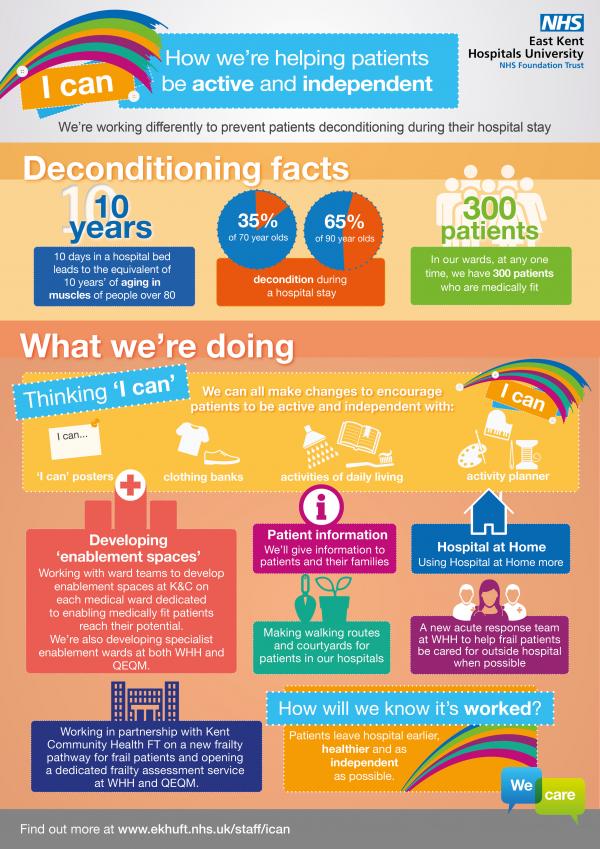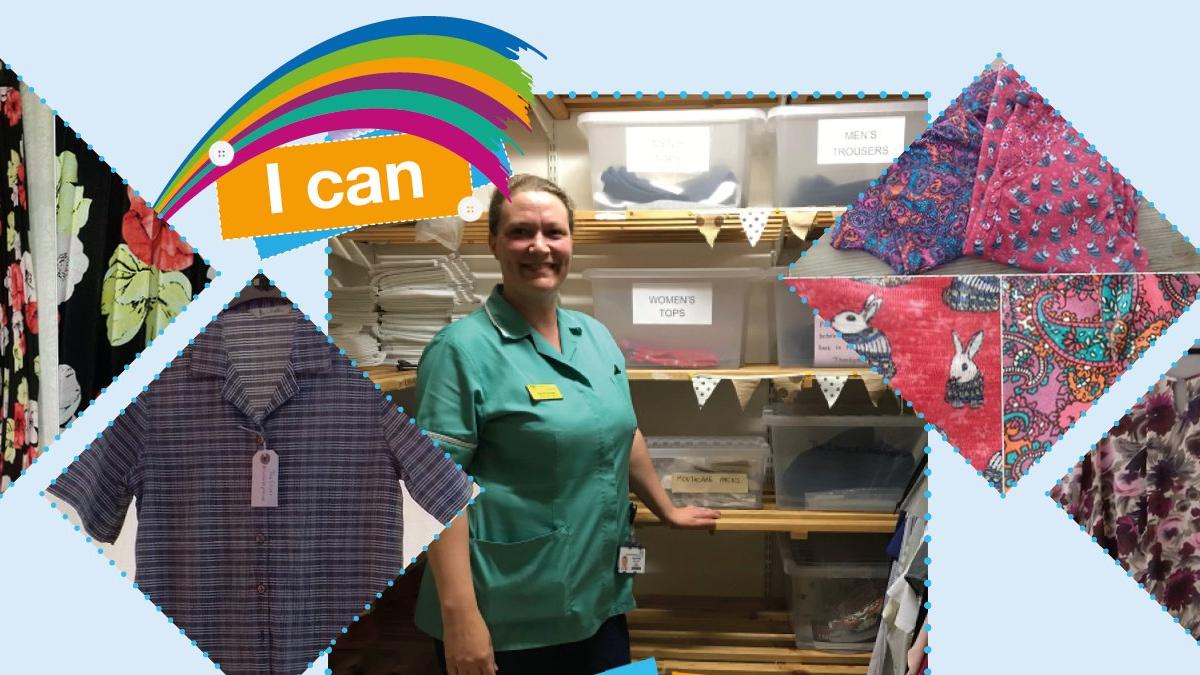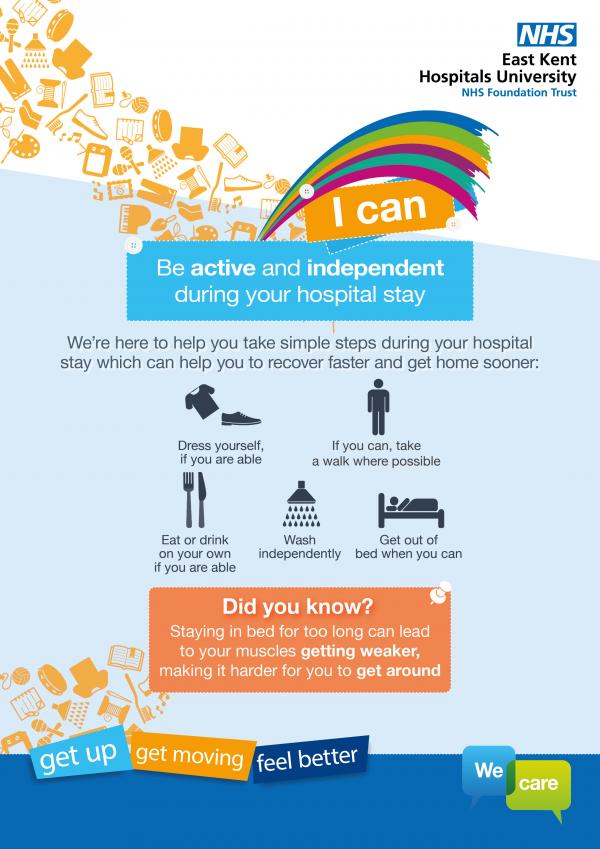A physiotherapist has introduced a simple but effective scheme to help patients get up, get moving and regain their independence.

The ‘I can’ initiative, which is now being rolled out across East Kent Hospitals University Trust, uses bedside posters to list positive statements about a person’s current physical abilities.
Alex Armstrong, a physiotherapist at Kent Canterbury Hospital, came up with the idea and started the scheme in May, when he piloted the approach on his ward.
Mr Armstrong explains that the posters provide therapy and ward teams with a quick, clear guide about the type of activities they can encourage patients to achieve independently and work towards during their recovery.
‘Posters are located above each patient’s bed space and provide information about a patient’s capability, for example: "I can get out of bed with assistance of one and transfer to the toilet with a wheeled Zimmer frame and one person",’ he says.
‘The positive phrase of 'I can' emphasises what patients can do rather than focusing on what they can't do, and this allows all the staff who work on the ward to understand the patient’s functional capacity and mobilise them in a safe way.
‘And it also gives patients the support they require to get up and about and not stay in bed all day waiting for therapy staff.
Scheme spreads out after positive pilot results

Following a pilot of the ‘I can' posters on his ward, Mr Armstrong says nursing and support staff appeared to be more confident mobilising patients, and he noticed an increase in the amount of exercise patients were completing with ward staff..
‘After piloting it for a couple of weeks and observing the success we were having - with patients increasing mobility and independence, and positive feedback from staff, patients and their families - the scheme was rolled out across other wards in the hospital; not just to improve mobility but also to encourage functional activities like washing, dressing and feeding.’
As a result, the trust is now pushing through further changes within the trust and empowering staff and patients to do more while in hospital, with the aim of increasing independence, decreasing deconditioning, decreasing length of stay and increasing the satisfaction of stay within hospital.
‘It’s great for patients, because the more active and independent they are in hospital, the more they will be able to lead an active and independent life when they get back home,’ Mr Armstrong says.
‘The functional return and strengthening seen in patients on a local scale I know is proportional to the more regular exercise they are doing.
‘And being able to get up and do things makes being in hospital more enjoyable for them too.’
He adds that, as well as helping recovering patients to mobilise and regain their independence, the scheme can also be used for patients who are on end of life care.
‘As a nice message of "I can stay in bed to rest" ensures that everyone is aware to let these patients be left to rest.’
Clothing closets
In addition to the ‘I can’ posters, East Kent Hospitals University Trust has also introduced a range of other tools to encourage patients to get up and get dressed, whenever they can.
These include clothing closets, activity planners and anti-boredom trollies.

Clothing closets, which are now in use at three of its acute hospitals, allow patients - who may only have access to hospital-issued pyjamas or a limited range of their own clothing - to select items from a range of spare clothing, thereby enabling them to get dressed.
CSP member Clare Grover, a therapy assistant practitioner at William Harvey Hospital in Ashford, set up one of the clothing closets.
‘As part of my everyday role, I always try to help patients get up and get moving, encourage more independence and give them the opportunity to get dressed in their day clothes,’ she said.
‘However, I noticed that there were a vast amount of patients that had no access to clothes of their own...so 'The Closet ' was set up a year ago and we now provide clothing to needy patients who have nothing of their own.
People who benefit from the scheme include
- older patients who are being transferred from hospital to a new residential setting or nursing home, and have no clothes of their own to wear
- homeless people who are in need of extra items of clothing before they are discharged
- out of area trauma patients whose clothes had to be cut off during their initial urgent treatment
Ms Grover adds that information about the scheme at her hospital is posted on local neighbourhood social media pages to spread the word and encourage members of the public to donate clothes.
And Facebook and Twitter pages about the project, titled The Closet #clothesforpatients, have been set up to allow people to find out more.

'Once donations come in, I take them home, inspect them, launder and steam them, and then place them into the closet for use by our patients,’ Ms Grover explains.
‘We only use the very high quality clothing that is donated and we are scrupulous in our selection.
‘This year, we’ve been lucky enough to raise a few hundred pounds from coin drop boxes at the tills at a local supermarket, which has enabled us to purchase brand new clothing and much needed underwear.
‘And our trust charity the Friends of William Harvey have also been very kind in gifting us cash donations to boost our purchasing ability.’
Alongside the introduction of clothing closets, the trust is also striving to emphasise how important it is for patients and/or their families to bring their own clothes into hospital, as this allows patients to wear their own outfits and feel like themselves.
Activity schedules & anti-boredom trollies

Medical wards at the trust are also aiming to introduce activity schedules for patients. The idea is currently being piloted at Kent and Canterbury Hospital, where activities on the schedule include gardening, singing/music clubs, exercise classes and breakfast and lunch clubs, which aim to encourage patients to enjoy meal times.
Anti-boredom trollies are also being piloted at William Harvey Hospital.
The trollies, which are equipped with various games and activities, aim to encourage interaction among patients and provide mental stimulation.
And at the same hospital, nursery clubs are also being offered during school term time, to allow patients to take part in arts and crafts activities with children.
Following the roll-out of the ‘I can’ scheme and these other initiatives, the trust is now beginning audits to measure how many patients are up, dressed and mobile.
Author: Robert Millett
Find Out More
Number of subscribers: 3



































